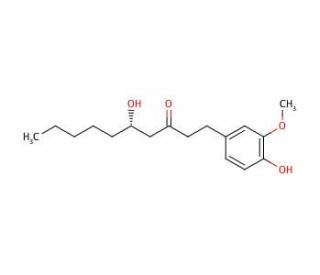

Gingerol (CAS 23513-14-6)
Voir les citations produits (5)
ACCÈS RAPIDE AUX LIENS
Le gingérol, une substance phénolique et un puissant agent cardiotonique isolé du rhizome de gingembre, peut agir pour stimuler l'activité de pompage du Ca2+ du réticulum sarcoplasmique (SR) des lapins de manière dépendante de la concentration. Il a été noté que le gingérol activait spécifiquement la SERCA (Ca2+-ATPase du réticulum cardiaque et squelettique). D'autres recherches ont montré que le gingérol inhibait l'agrégation plaquettaire en supprimant la production de thromboxane. Le gingérol bloque la libération d'ATP des plaquettes induite par l'adrénaline et l'adénosine 5-diphosphate et prévient l'agrégation secondaire. Il a été démontré que le gingérol possède des caractéristiques antioxydantes et anti-inflammatoires et qu'il peut inhiber de manière significative la papillomagénèse cutanée induite par le 7,12-diméthylbenz[a]anthracène chez la souris. En outre, le gingérol a été noté comme un agoniste du VR1 (récepteur vanilloïde) activé par la capsaïcine et, dans les études sur les cellules leucémiques, il pourrait avoir des propriétés apoptotiques.
Gingerol (CAS 23513-14-6) Références
- Induction de l'apoptose dans les cellules HL-60 par des vanilloïdes piquants, le [6]-gingérol et le [6]-paradol. | Lee, E. and Surh, YJ. 1998. Cancer Lett. 134: 163-8. PMID: 10025876
- Les gingérols: une nouvelle classe d'agonistes des récepteurs vanilloïdes (VR1). | Dedov, VN., et al. 2002. Br J Pharmacol. 137: 793-8. PMID: 12411409
- Le facteur 1 alpha induit par le gingérol inhibe la neurotoxicité médiée par le peptide prion humain. | Jeong, JK., et al. 2013. Phytother Res. 27: 1185-92. PMID: 23008012
- Le gingérol, un nouvel agent cardiotonique, active l'ATPase de pompage du Ca2+ dans le réticulum sarcoplasmique squelettique et cardiaque. | Kobayashi, M., et al. 1987. Biochim Biophys Acta. 903: 96-102. PMID: 2443170
- Influence du traitement au gingérol sur la toxicité de l'aluminium chez le rat. | Shrivastava, S. 2015. J Environ Pathol Toxicol Oncol. 34: 11-21. PMID: 25746828
- Le gingérol inhibe la prolifération des cellules musculaires lisses vasculaires induite par le sérum et l'hyperplasie néointimale induite par la blessure en supprimant l'activation de la MAPK p38. | Jain, M., et al. 2016. J Cardiovasc Pharmacol Ther. 21: 187-200. PMID: 26240073
- Le gingérol inverse l'effet cancérigène de la capsaïcine en augmentant le niveau de TRPV1 dans un modèle cancérigène pulmonaire induit par l'uréthane. | Geng, S., et al. 2016. J Agric Food Chem. 64: 6203-11. PMID: 27436516
- Le gingérol active le canal ionique du froid nocif TRPA1 dans le tractus gastro-intestinal. | Yang, MQ., et al. 2016. Chin J Nat Med. 14: 434-40. PMID: 27473961
- Effets anti-inflammatoires du gingérol sur les cellules RAW 264.7 stimulées par le lipopolysaccharide en inhibant la voie de signalisation NF-κB. | Liang, N., et al. 2018. Inflammation. 41: 835-845. PMID: 29508185
- La montée du gingérol en tant que molécule anti-QS: L'épisode le plus sombre de la saga de la bioluminescence médiée par LuxR. | Parmar, P., et al. 2020. Bioorg Chem. 99: 103823. PMID: 32283347
- Breaking bad: Mieux vaut appeler gingérol pour améliorer la sensibilité aux antibiotiques de Pseudomonas aeruginosa en inhibant plusieurs voies de détection du quorum. | Shukla, A., et al. 2021. Microbiol Res. 252: 126863. PMID: 34530246
- Le gingérol améliore les dommages neuronaux induits par l'hypoxie-réoxygénation via l'axe miR-210/facteur neurotrophique dérivé du cerveau. | Zhai, Y., et al. 2022. Kaohsiung J Med Sci. 38: 367-377. PMID: 34962339
- Bioactivité des fractions de gingérol contre la cytotoxicité de la butanone induite chez les nouveau-nés de souris. | Othman, SI., et al. 2022. Eur Rev Med Pharmacol Sci. 26: 6512-6522. PMID: 36196700
- Approche chromatographique intégrée pour la découverte de gingérols antioxydants provenant de Dracocephalum heterophyllum et de leurs cibles potentielles. | Dang, J., et al. 2022. Anal Methods. 14: 4133-4145. PMID: 36226573
- Effet antiplaquettaire du gingérol isolé de Zingiber officinale. | Guh, JH., et al. 1995. J Pharm Pharmacol. 47: 329-32. PMID: 7791032
Informations pour la commande
| Nom du produit | Ref. Catalogue | COND. | Prix HT | QTÉ | Favoris | |
Gingerol, 5 mg | sc-201519 | 5 mg | $107.00 | |||
Gingerol, 20 mg | sc-201519A | 20 mg | $379.00 |
